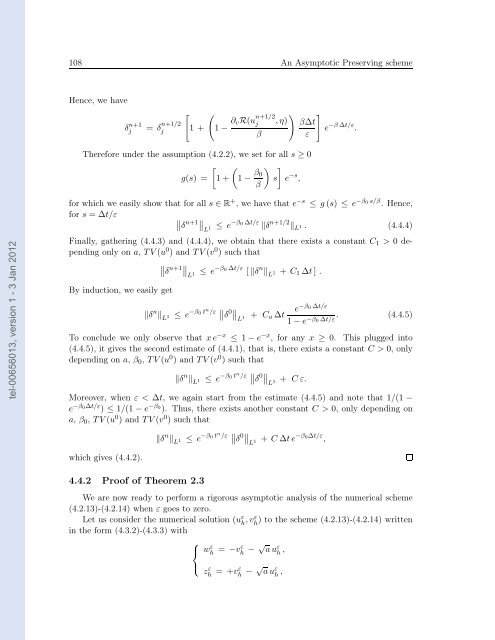Modélisation, analyse mathématique et simulations numériques de ...
Modélisation, analyse mathématique et simulations numériques de ...
Modélisation, analyse mathématique et simulations numériques de ...
Create successful ePaper yourself
Turn your PDF publications into a flip-book with our unique Google optimized e-Paper software.
tel-00656013, version 1 - 3 Jan 2012<br />
108 An Asymptotic Preserving scheme<br />
Hence, we have<br />
δ n+1<br />
j = δ n+1/2<br />
j<br />
<br />
1 +<br />
<br />
1−<br />
n+1/2 <br />
∂vR(uj ,η)<br />
β<br />
Therefore un<strong>de</strong>r the assumption (4.2.2), we s<strong>et</strong> for all s ≥ 0<br />
<br />
g(s) = 1+ 1− β0<br />
<br />
s e<br />
β<br />
−s ,<br />
<br />
β∆t<br />
e<br />
ε<br />
−β∆t/ε .<br />
for which we easily show that for all s ∈ R + , we have that e −s ≤ g(s) ≤ e −β0s/β . Hence,<br />
for s = ∆t/ε δ n+1 L 1 ≤ e −β0∆t/ε δ n+1/2 L 1 . (4.4.4)<br />
Finally, gathering (4.4.3) and (4.4.4), we obtain that there exists a constant C1 > 0 <strong>de</strong>pending<br />
only on a, TV(u 0 ) and TV(v 0 ) such that<br />
<br />
δ n+1 L 1 ≤ e −β0∆t/ε [δ n L 1 + C1∆t] .<br />
By induction, we easily g<strong>et</strong><br />
δ n L 1 ≤ e −β0t n /ε δ 0 L 1 + Ca∆t<br />
e−β0∆t/ε . (4.4.5)<br />
1−e −β0∆t/ε<br />
To conclu<strong>de</strong> we only observe that xe −x ≤ 1−e −x , for any x ≥ 0. This plugged into<br />
(4.4.5), it gives the second estimate of (4.4.1), that is, there exists a constant C > 0, only<br />
<strong>de</strong>pending on a, β0, TV(u 0 ) and TV(v 0 ) such that<br />
δ n L 1 ≤ e −β0t n /ε δ 0 L 1 + Cε.<br />
Moreover, when ε < ∆t, we again start from the estimate (4.4.5) and note that 1/(1 −<br />
e −β0∆t/ε ) ≤ 1/(1 −e −β0 ). Thus, there exists another constant C > 0, only <strong>de</strong>pending on<br />
a, β0, TV(u 0 ) and TV(v 0 ) such that<br />
which gives (4.4.2).<br />
4.4.2 Proof of Theorem 2.3<br />
δ n L 1 ≤ e −β0t n /ε δ 0 L 1 + C∆te −β0∆t/ε ,<br />
We are now ready to perform a rigorous asymptotic analysis of the numerical scheme<br />
(4.2.13)-(4.2.14) when ε goes to zero.<br />
L<strong>et</strong> us consi<strong>de</strong>r the numerical solution (uε h ,vε h ) to the scheme (4.2.13)-(4.2.14) written<br />
in the form (4.3.2)-(4.3.3) with<br />
⎧<br />
⎨ wε h = −vε h − √ auε h ,<br />
⎩<br />
z ε h = +vε h − √ au ε h ,

















